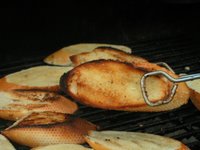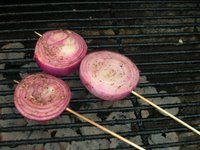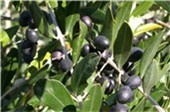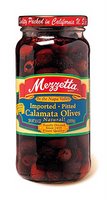Ingredients:
to grill...
1 loaf Italian crusty bread (or baguette)
1 red bell pepper (see "technique")
2 red onions, cut into 1 in. rings, lollipopped
toss together...
2 tomatoes, diced
1 cucumber, sliced thin or diced
Several small Italian sweet peppers, sliced (or another chopped red or green bell pepper)
1/2 cup Kalamata olives, halved (see "special ingredient")
10+ large leaves of basil, rolled and sliced
10+ stems of parsley, chopped
1/2 cup feta, crumbled (grated Parmesan is good too, you could also use cubed fontina)
Whisk together...
1/4 red wine vinegar
1/4 lemon juice
2 cloves of garlic, minced
Salt (maybe about a 1/2 t or so)
Fresh ground black pepper to taste
Then whisk in...
1/2+ cup olive oil

Slice the bread into 1 in. thick pieces then lightly butter both sides of each slice (some garlic added to the butter is really good). Grill or broil the bread until somewhat crusty and golden. If you don't toast the bread it will absorb too much of the dressing and become soggy. Grilling the bread adds a wonderful smoky flavor to it as well.
To char the pepper:
This can be done on the grill or underneath the broiler. Charring the pepper does a really neat thing to the flavor and texture of the pepper, and I use this technique quite a bit. If you want to skip this step, the supper market does sell jarred peppers under the label "roasted red bell peppers".
- If you are doing it on the grill, simply place it there and turn it until all sides are burnt. Don't worry about it turning black...that is the point. If you do this underneath the broiler, halve and seed the pepper before you char it.
- Take it off the grill and put it in a ziploc bag or container and seal. This loosens the skin for peeling and also softens the texture of the pepper.
- Peel the pepper then halve it and remove the seeds. Chop it into a 1/2 in. dice.



lollipopping the onion is so that it doesn't fall apart on the grill. Simply insert a sk
 ewer threw the rings until it pokes out the other side. Be careful not to poke yourself. If you do two onions with one ring on each skewer you'll need four skewers. If you wanted to marinate them (recommended) put them in a ziploc bag with some olive oil, red wine vinegar, garlic, salt, pepper, and maybe some herbs and let them marinate for about a half hour before you grill them, flipping the bag halfway through. I also like to smother them with balsamic vinegar while they cook (onions done this way are one of my favorite things to grill and make a great side dish by themselves). When they are sufficiently grilled take them off and chop them.
ewer threw the rings until it pokes out the other side. Be careful not to poke yourself. If you do two onions with one ring on each skewer you'll need four skewers. If you wanted to marinate them (recommended) put them in a ziploc bag with some olive oil, red wine vinegar, garlic, salt, pepper, and maybe some herbs and let them marinate for about a half hour before you grill them, flipping the bag halfway through. I also like to smother them with balsamic vinegar while they cook (onions done this way are one of my favorite things to grill and make a great side dish by themselves). When they are sufficiently grilled take them off and chop them.When all the other ingredients and the dressing are all prepared (chopped, diced, sliced, etc), toss everything in a serving bowl and serve.
 This salad is great with grilled anything (beef, steak, chicken, fish, eggplant, frog legs, etc.)
This salad is great with grilled anything (beef, steak, chicken, fish, eggplant, frog legs, etc.)Special Ingredient: Calamata Olives
In case these are unfamiliar to some of you I thought I’d talk about them a little. Calamata (or
 Kalam
Kalam ata) olives originated in
ata) olives originated in 







